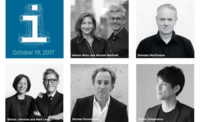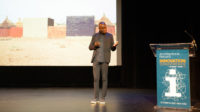RECORD 2012 Innovation Conference: Shaping the Future

RECORD Innovation Conference: Shaping the Future
Diébédo Francis Kéré addresses the audience.
Photo © Steve Hill

RECORD Innovation Conference: Shaping the Future
Diébédo Francis Kéré presenting.
Photo © Steve Hill

RECORD Innovation Conference: Shaping the Future
Chicago-based architect Jeanne Gang of Studio Gang Architects
Photo © Steve Hill

RECORD Innovation Conference: Shaping the Future
Tanzanian-born, London-based architect David Adjaye
Photo © Steve Hill

RECORD Innovation Conference: Shaping the Future
William Pedersen of Kohn Pedersen Fox
Photo © Steve Hill

RECORD Innovation Conference: Shaping the Future
From left: William F. Baker of Skidmore, Owings & Merrill; William Pedersen of Kohn Pedersen Fox; and Gordon Gill of Adrian Smith + Gordon Gill Architecture
Photo © Steve Hill






In a time of 24/7 connectivity and cloud computing, it is essential for architects to make room for “forms of low-tech creativity,” said Jeanne Gang, principal of Chicago-based Studio Gang Architects, describing both the way she designs (by hand as well as by computer) and the materials she uses in her buildings. For the Arcus Center for Social Justice Leadership at Kalamazoo College in Michigan, she is working with “wood masonry”—slices of logs that, in their diversity, remind her of the people who will benefit from the center.
The need to balance technology and the human touch was a note sounded often during the 10th annual architectural record Innovation conference. Gang was the first of more than a dozen speakers in this year’s program, titled “Design Leaders Envision the Next Decade.” The event drew some 400 attendees to the auditorium of the McGraw-Hill Building in Manhattan. Many presenters rejected the idea that architects should take their cues from algorithms; as Francis Aish of Foster + Partners put it, “Sometimes the computer can be too objective.” Dennis Shelden, Gehry Technologies chief technology officer, sees his goal as more, not less, personalization. “Lurking in there,” Shelden said of the advances in building information modeling, “is the possibility of connection to identity and individuality.”
Gang, who spoke in the morning, remained to hear the afternoon presenters, including Diébédo Francis Kéré. The principal of Berlin-based Francis Kéré Architecture showed photos of schools he has designed for his native Burkina Faso, where villagers help to erect the compressed-earth structures. He described one scene of a partially completed building covered in plastic to protect it from a heavy rainfall: “It looks like Christo and Jeanne-Claude,” he said, eliciting a laugh. Otherwise, his talk was heart-rending. With extraordinary modesty he told the crowd, “I don’t know what to call my work, but when you call it architecture, you make me proud.” He is now building a library in his hometown, Gando, a place where access to books—and education—is still, he said, “an unreachable dream for many.
Kéré was followed by another African-born architect, London-based David Adjaye, whose own Francis Gregory Library in Washington, D.C., serves as a gathering place and beacon. A few miles away, on the National Mall, work has begun on the Smithsonian National Museum of African American History and Culture, which Adjaye designed as part of a team (Freelon Adjaye Bond/Smithgroup). Adjaye described some of the technological challenges posed by the project—numerous sensors are being used to ensure that construction doesn’t destabilize the Washington Monument—but also its human elements, with both African and African-American art forms influencing the design. The plan for the museum’s main hall calls for a ceiling of half a million wooden planks, lit from above. Positioned under any one of them, Adjaye says, “you become the figure in the story.”
Much of the day was devoted to discussion of technological advances. Kent Larson, principal research scientist at the MIT Media Lab, showed a project for a car that folds, parks, and charges itself (currently being tested in Spain). Sheila Kennedy, of Kennedy & Violich Architecture, presented a group of rowhouses, now under construction in Germany, in which curtains rearrange themselves to create microclimates. “It’s an old idea about curtains and tapestries,” Kennedy said, “but in a new, specialized way.”
During a panel discussion on supertall buildings, the masters Gordon Gill (of Adrian Smith + Gordon Gill Architecture), William Pedersen (of Kohn Pedersen Fox), and William F. Baker (of Skidmore, Owings & Merrill) described their towers as cultural, as much as technological, achievements. And Stephen Selkowitz of the Lawrence Berkeley National Laboratory talked about the work he and his colleagues do to test building performance, but he urged that architects not let themselves be slaves to data. “Studying things is fine,” he said, “but getting things going is better.”
At another panel discussion, four alums of RECORD’s Design Vanguard (Sebastian Schmaling, Jennifer Luce, Eric Bunge, and Marc Tsurumaki) described the challenges of advancing their practices during a down economy. They got good advice from Stephen Kieran, principal of KieranTimberlake, who was asked at the end of his presentation how architects can avoid giving their innovations away. At the beginning of every project, he said of his Philadelphia-based firm, “we articulate a research agenda” and build it into the contract price. That’s not always possible, he said. “But a client that isn’t interested in a research agenda probably isn’t a great match anyway.”












